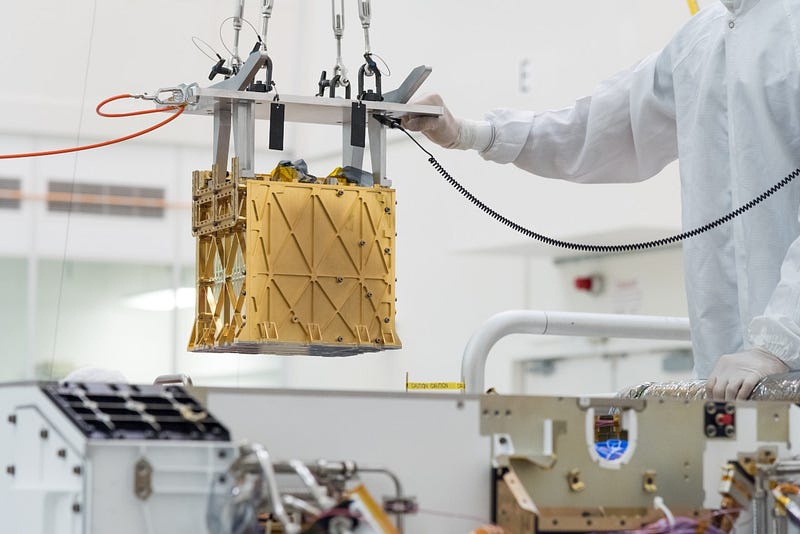Oxygen Production on Mars: A Leap Toward Human Habitation
Written on
Exploring the Need for Oxygen on Mars
The concept of generating oxygen on Mars brings humanity one step closer to potential colonization of the Red Planet. The Mars Oxygen In-Situ Resource Utilization Experiment, known as MOXIE, has made history by producing a small quantity of this vital gas aboard the Perseverance rover.

Mars' atmosphere is predominantly composed of approximately 96% carbon dioxide. This gas can be chemically transformed into oxygen and carbon monoxide, the latter being a byproduct. However, this conversion has never been achieved on another planet—until now.
MOXIE: A Game-Changer for Mars Exploration
On April 20, the MOXIE instrument, which is about the size of a toaster, successfully separated oxygen from the thin, carbon-dioxide-laden atmosphere of Mars. "MOXIE is a concise name for a tool that paves the way for human exploration on Mars. It generates oxygen right at its source on the Red Planet," explains NASA.
Transporting air, water, and other necessities for life to another planet presents immense challenges and expenses. Therefore, utilizing local resources to produce these essential compounds is critical for establishing a human presence on the Moon, Mars, and beyond.
"This is a vital initial step towards converting carbon dioxide into breathable oxygen on Mars. Although MOXIE has more work ahead, the success of this technology demonstration is promising as we aim for a future with human inhabitants on Mars. Oxygen is not just crucial for breathing; it is also a key component for rocket fuel, which future explorers will need for their return journey," stated Jim Reuter, associate administrator for NASA's Space Technology Mission Directorate (STMD).
The Future of Space Travel and Oxygen Needs
Rocket engines require oxygen to ignite, and the demands of space travel will far exceed the oxygen needs of Martian colonists. A small colony could consume around one metric ton of breathable oxygen annually. Notably, launching four astronauts from Mars would necessitate approximately 25 metric tons of oxygen, an amount comparable to the weight of a space shuttle, alongside seven metric tons of fuel.
Transporting such a massive quantity of oxygen to Mars would be financially unfeasible; however, sending a one-ton converter is considerably more practical and efficient. While MOXIE resembles a car battery, future equipment designed for oxygen extraction will need to be as large as a car.
The Progress of MOXIE and Future Plans
“It’s not that simple. We’re talking about going to Mars. Living on Mars! How can I give up becoming one of the colonizers of another planet?” - Rita Carla Francesca Monticelli, Deserto rosso — Punto di non ritorno.
During its initial test, MOXIE generated approximately five grams of oxygen, enough for an individual to breathe for roughly ten minutes. When operating at full capacity, it is expected to produce around ten grams of oxygen per hour. Over the next Martian year, which corresponds to about two Earth years, researchers plan to conduct at least nine additional, increasingly complex tests with MOXIE, assessing its performance under varying conditions throughout different seasons.
Advancing Technologies for Resource Extraction
To enable long-term human settlement on Mars, technologies akin to MOXIE will need to be developed for extracting vital resources, such as oxygen, from local materials. “It involves processing regolith, the material found on the Martian surface, and converting carbon dioxide—abundant in the atmosphere—into oxygen. This process transforms these plentiful materials into useful resources: propellant, breathable air, or, when combined with hydrogen, water,” stated Trudy Kortes, director of technology demonstrations at STMD.
The conversion process of carbon dioxide into oxygen requires temperatures around 800°C (1,470°F). MOXIE is constructed with 3D-printed nickel alloy components and a lightweight aerogel to retain heat. Additionally, the unit is coated with a thin layer of gold to reflect infrared radiation, safeguarding the rest of the rover from excessive heat.
The Perseverance rover is designed to investigate various aspects of Mars, including the potential for past life. Another groundbreaking technology demonstration was conducted during the first test flights of Ingenuity, the first helicopter to achieve powered flight on another planet.
Regardless of whether Perseverance uncovers signs of ancient life, its successful production of oxygen on Mars marks a significant milestone in preparing for future human exploration of the Red Planet.
James Maynard is the founder and publisher of The Cosmic Companion. A New England native, he now resides in Tucson with his wife, Nicole, and their cat, Max.
Did you find this article engaging? Join us on The Cosmic Companion Network for our podcast, weekly video series, informative newsletter, and news briefings on Amazon Alexa and more!